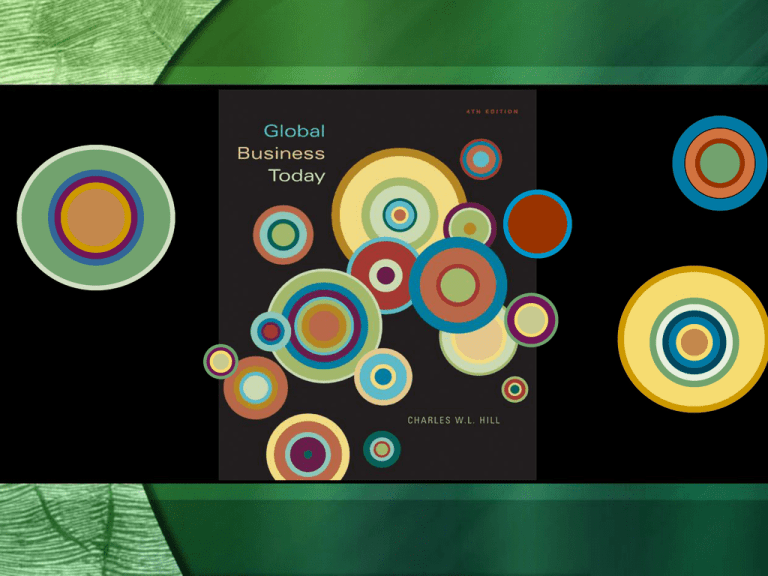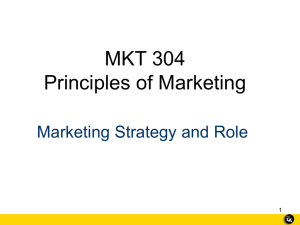
Chapter 3
Differences
in Culture
3-3
Differences in Culture
• Societies’ differ along cultural dimensions
• What is culture?
• How/why do social structure, religion, language influence
cultural differences?
• What are differences between culture and values in the
workplace (corporate culture)?
• Culture changes over time. What are some reasons behind
this?
• Implications for business managers
McGraw-Hill/Irwin
Global Business Today, 4/e
© 2006 The McGraw-Hill Companies, Inc., All Rights Reserved.
3-4
What is Culture?
• Culture: a society’s (group’s) system of shared,
learned values and norms; these are the society’s
(group’s) design for living
- Values: abstract ideas about the good, the right,
the desirable
- Norms: social rules and guidelines; guide
appropriate behavior for specific situations
• Folkways: norms of little moral significance
- dress code; table manners; timeliness
• Mores: norms central to functioning of social life
- bring serious retribution: thievery, adultery, alcohol
McGraw-Hill/Irwin
Global Business Today, 4/e
© 2006 The McGraw-Hill Companies, Inc., All Rights Reserved.
3-5
What is Culture?
“the collective programming of the mind which
distinguishes the members of one human group
over another…
Culture, in this sense, includes systems of values;
and values are among the building blocks of
culture”
Geert Hofstede
McGraw-Hill/Irwin
Global Business Today, 4/e
© 2006 The McGraw-Hill Companies, Inc., All Rights Reserved.
3-6
National Culture
“Nation” is a useful:
- Definition of society
• similarity among people a cause -- and effect -- of national
boundaries
- Way to bound and measure culture for conduct of
business
• culture is a key characteristic of society
• can differ significantly across national borders
- also within national borders
• laws are established along national lines
• Culture is both a cause and an effect of economic and
political factors that vary across national borders
McGraw-Hill/Irwin
Global Business Today, 4/e
© 2006 The McGraw-Hill Companies, Inc., All Rights Reserved.
3-7
Social Structure and Culture
• Unit of social organization: individual or group?
• Society may be stratified into classes or castes
- High-low stratification
- High-low mobility between strata
• The individual: building block of many Western societies
- Entrepreneurship
- Social, geographical and inter-organizational mobility
• The group:
- Two or more associated individuals with a shared
identity
- Interact with each-other in specific ways on the basis of a
common set of expectations.
McGraw-Hill/Irwin
Global Business Today, 4/e
© 2006 The McGraw-Hill Companies, Inc., All Rights Reserved.
3-8
Individual vs Group
Societal Characteristics
• Individual
- Managerial mobility
between companies
- Economic dynamism,
innovation
- Good general skills
- Team work difficult,
non-collaborative
• Exposure to different ways of
doing business
- e.g., U.S. companies
McGraw-Hill/Irwin
Global Business Today, 4/e
• Group
- Loyalty and commitment to
company
- In-depth knowledge of
company
- Specialist skills
- Easy to build teams,
collaboration
- Emotional identification with
group or company
- e.g., Japanese companies
© 2006 The McGraw-Hill Companies, Inc., All Rights Reserved.
3-9
Religion, Ethics and Culture
• Religion: system of shared beliefs about the sacred
• Ethical systems: moral principles or values that shape
and guide behavior; often products of religion
• Major religious groups and some economic
implications
- Christianity
- Islam
- Hinduism
stratified
- Buddhism
- Confucianism
McGraw-Hill/Irwin
Global Business Today, 4/e
protestant work ethic
Islamic economic principles
anti-materialistic, socially
anti-materialistic, social equality
hierarchy, loyalty, honesty
© 2006 The McGraw-Hill Companies, Inc., All Rights Reserved.
3 - 10
Language: Culture Bound
• Language, spoken
- “private” does not exist as a word in many
languages
- Eskimos: 24 words for snow
- Words which describe moral concepts can be
unique to countries or areas
- Spoken language precision important in lowcontext cultures
• Language, unspoken
- Context... more important than spoken word in
high context cultures
McGraw-Hill/Irwin
Global Business Today, 4/e
© 2006 The McGraw-Hill Companies, Inc., All Rights Reserved.
3 - 11
High/Low Context Cultures
High-Context
Crucial to Communications:
external environment, situation, non-verbal behavior
Relationships:
long lasting, deep personal mutual involvement
Communication:
economical, fast because of shared "code"
Authority person:
responsible for actions of subordinates, loyalty at a
premium
Agreements:
spoken, flexible and changeable
Insiders vs outsiders: very distinguishable
Cultural pattern change: slow
Low-Context
explicit information, blunt communicative
style
short duration, heterogeneous populations
explicit messages, low reliance on non verbal
diffused through bureaucratic system,
personal responsibility tough to pin down
written, final and binding, litigious, more
lawyers
difficult to identify, foreigners can adjust
faster
See E.T. Hall & M.R. Hall, Understanding cultural differences, 1990, Intercultural Press
McGraw-Hill/Irwin
Global Business Today, 4/e
© 2006 The McGraw-Hill Companies, Inc., All Rights Reserved.
3 - 12
Education and Culture
• Education
- Medium through which people are acculturated
- Language, “myths,” values, norms taught
- Teaches personal achievement and competition
- Critical to national competitive advantage
• Education system may be a cultural outcome
McGraw-Hill/Irwin
Global Business Today, 4/e
© 2006 The McGraw-Hill Companies, Inc., All Rights Reserved.
3 - 13
Culture and the workplace (Hofstede)
• Hofstede finds national culture dimensions meaningful to
business
• Basis:
- Work related values not universal
- National values may persist over MNC efforts to create
corporate culture
- Home country values often used to determine HQ policies
- MNC may create morale problems with uniform moral
norms
• Purpose: understanding of business situations across-cultures
• MUST understand own culture AND other culture(s)
McGraw-Hill/Irwin
Global Business Today, 4/e
© 2006 The McGraw-Hill Companies, Inc., All Rights Reserved.
3 - 14
Power Distance -- (Hofstede)
• Degree of social inequality considered
normal by people
• Distance between individuals at different
levels of a hierarchy
• Scale: from equal (small power distance) to
extremely unequal (large power distance)
McGraw-Hill/Irwin
Global Business Today, 4/e
© 2006 The McGraw-Hill Companies, Inc., All Rights Reserved.
3 - 15
Individualism Vs. Collectivism
(Hofstede)
• Degree to which people in a country
prefer to act as individuals rather
than in groups
• Describes the relations between the
individual and his/her fellows
McGraw-Hill/Irwin
Global Business Today, 4/e
© 2006 The McGraw-Hill Companies, Inc., All Rights Reserved.
3 - 16
Uncertainty Avoidance (Hofstede)
• Degree of need to avoid uncertainty about the
future
• Degree of preference for structured versus
unstructured situations
- Structured situations: have tight rules may or
may not be written down
• High uncertainty avoidance: people with more
nervous energy (vs easy-going), rigid society,
"what is different is dangerous."
McGraw-Hill/Irwin
Global Business Today, 4/e
© 2006 The McGraw-Hill Companies, Inc., All Rights Reserved.
3 - 17
McGraw-Hill/Irwin
Global Business Today, 4/e
© 2006 The McGraw-Hill Companies, Inc., All Rights Reserved.
3 - 18
Masculinity Vs. Femininity (Hofstede)
• Division of roles and values in a society
• Masculine values prevail:
- assertiveness, success, competition
• Feminine values prevail:
- quality of life, maintenance of warm
personal relationships, service, care for
the weak, solidarity
McGraw-Hill/Irwin
Global Business Today, 4/e
© 2006 The McGraw-Hill Companies, Inc., All Rights Reserved.
3 - 19
Confucian Dynamism (Hofstede)
• Attitudes towards
- Time
- Persistence
- Status in society
- “Face”
- Respect for tradition
- Gifts and favors
McGraw-Hill/Irwin
Global Business Today, 4/e
© 2006 The McGraw-Hill Companies, Inc., All Rights Reserved.
3 - 20
Cultural Change Over Time
• Change is slow and often painful
• Shifts away from “traditional values”
towards “secular values”
• Changes with shift from “survival
values” to “self-expression values”
McGraw-Hill/Irwin
Global Business Today, 4/e
© 2006 The McGraw-Hill Companies, Inc., All Rights Reserved.
3 - 21
McGraw-Hill/Irwin
Global Business Today, 4/e
© 2006 The McGraw-Hill Companies, Inc., All Rights Reserved.
3 - 22
Cultural Distance
• Geographic and cultural (or psychic)
distance among countries may not be
the same
• Key concept which can affect IB
strategy and conduct
McGraw-Hill/Irwin
Global Business Today, 4/e
© 2006 The McGraw-Hill Companies, Inc., All Rights Reserved.
3 - 23
Managerial Implications
• Ethnocentrism vs Polycentrism
• Must a company adapt to local
cultures or can corporate -- often
home-country dominated -- culture
prevail?
• Cross-cultural literacy essential
• Do some cultures offer a national
competitive advantage over others?
McGraw-Hill/Irwin
Global Business Today, 4/e
© 2006 The McGraw-Hill Companies, Inc., All Rights Reserved.





